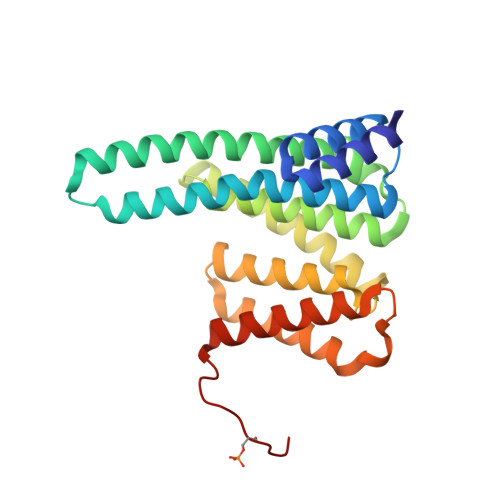Crystal structure of human 14-3-3 zeta complexed with the noncanonical phosphopeptide from proapoptotic BAD.
Sluchanko, N.N., Tugaeva, K.V., Gushchin, I., Remeeva, A., Kovalev, K., Cooley, R.B.(2021) Biochem Biophys Res Commun 583: 100-105
- PubMed: 34735870
- DOI: https://doi.org/10.1016/j.bbrc.2021.10.053
- Primary Citation of Related Structures:
7Q16 - PubMed Abstract:
Several signaling pathways control phosphorylation of the proapoptotic protein BAD and its phosphorylation-dependent association with 14-3-3 proteins in the cytoplasm. The stability of the 14-3-3/BAD complex determines the cell fate: unphosphorylated BAD escapes from 14-3-3, migrates to the mitochondria and initiates apoptosis. While the 14-3-3/BAD interaction represents a promising drug target, it lacks structural characterization. Among several phosphosites identified in vivo, Ser75 and Ser99 of human BAD match the consensus sequence RXXpSXP recognized by 14-3-3 and, therefore, represent canonical 14-3-3-binding sites. Yet, BAD contains other serines phosphorylatable in vivo, whose role is less understood. Here, we report a 2.36 Å crystal structure of 14-3-3ζ complexed with a BAD fragment which includes residues Ser74 and Ser75, both being substrates for protein kinases. While the BAD peptide is anchored to 14-3-3 by phosphoserine as expected, the BAD peptide was unexpectedly phosphorylated at Ser74 instead of Ser75, revealing noncanonical binding within the amphipathic groove and leading to a one-step positional shift and reorganization of the interface. This observation exemplifies plasticity of the amphipathic 14-3-3 groove in accommodating various peptides and suggests the redundancy of Ser74 and Ser75 phosphosites with respect to binding of BAD to 14-3-3.
- A.N. Bach Institute of Biochemistry, Federal Research Center of Biotechnology of the Russian Academy of Sciences, 119071, Moscow, Russia. Electronic address: nikolai.sluchanko@mail.ru.
Organizational Affiliation:

















